Class Mammalia
Order Carnivora
Family Canidae
Vulpes macrotis/velox—Kit or Swift Fox // Vulpes macrotis—Kit Fox // Vulpes velox—Swift Fox // Vulpes vulpes—Red Fox
The three red foxes of the Southwest include one species, Vulpes vulpes, widespread in both Old and New Worlds but marginal in the Southwest where it is mostly a northern montane species; one species, V. velox, primarily a Great Plains species; and one a desert species, V. macrotis. Not surprisingly, some ranges shifted with climate changes.
Identification of the three species is largely on size, though skull characteristics, such as bullar size, are important when available. Post-cranial elements of the smaller species are potentially prone to confusion with those of Urocyon.
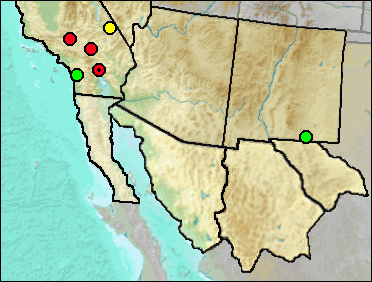
Sites.
Late Blancan: Tecopa Lake Beds (Woodburne and Whistler 1991: ? gen.)
Irvingtonian: Elsinore: Microtus/Mammuthus (Pajak et al. 1996).
Medial Irvingtonian: Slaughter Canyon Cave (Morgan and Harris 2015).
Rancholabrean: Bedford Properties (Jefferson 1991b: cf. gen.); Broadwell Lake East (Jefferson 1991b); Clay Mine Road (Jefferson 2014).
Literature.
Jefferson 1991b, 2014; Morgan and Harris 2015; Pajak et al. 1996; Woodburne and Whistler 1991.
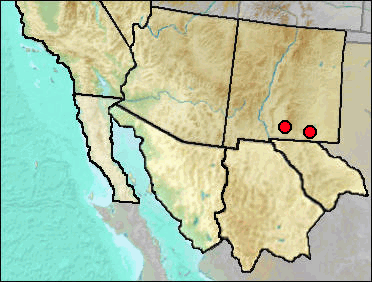
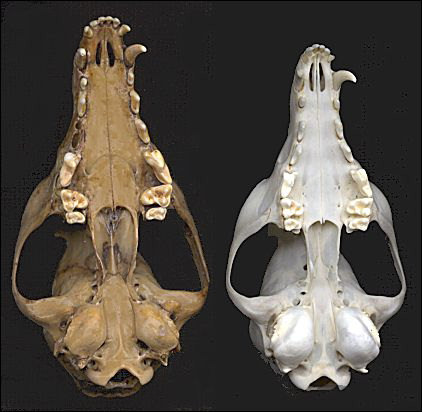 There has
been debate over the years as to whether Vulpes macrotis and V. velox
represent subspecies or species. Dragoo et al. (1990) concluded that the two
represented one species. However, Mercure et al. (1993), based on mitochondrial DNA,
concluded that they are separate species mainly separated geographically by the Rocky
Mountains, but with some hybridization in southeastern New Mexico. The fossil foxes of
this area then attain particular importance since the Guadalupe Mountains fossil sites
are within the zone of hybridization.
There has
been debate over the years as to whether Vulpes macrotis and V. velox
represent subspecies or species. Dragoo et al. (1990) concluded that the two
represented one species. However, Mercure et al. (1993), based on mitochondrial DNA,
concluded that they are separate species mainly separated geographically by the Rocky
Mountains, but with some hybridization in southeastern New Mexico. The fossil foxes of
this area then attain particular importance since the Guadalupe Mountains fossil sites
are within the zone of hybridization.
Fig. 1. Fossil skull of Vulpes velox (UTEP 120-1 from the Clay Shaft 27.5-ft level, Big Manhole Cave) compared to a modern skull of Vulpes macrotis. Note especially the difference in bullar and overall size.
There is a major difference in the fox faunas of the sites in the Guadalupe Mountains region and those in the southern portion of New Mexico to the west. Such cave faunas as Dry and Big Manhole are rich in small red foxes; this also is the case in the more northern sites to the west: the Isleta Caves. Southern sites west of the Guadalupe Mountains lack fossils surely assignable to Vulpes. U-Bar Cave has no specimens assigned to Vulpes, and of the three small fox elements from Pendejo Cave, one mid Wisconsin fragment is tentatively identified as possible Vulpes.
Tebedge (1988) listed V. macrotis from Dark Canyon Cave and noted that V. macrotis was largely recognizable from V. velox by the relatively larger auditory bullae of the latter. However, his specimens consisted of two mandibular fragments only. Since most Wisconsin-age specimens are V. velox, I have recorded this as inconclusive as to which species is recorded.
Sites.
Mid Wisconsin: Pendejo Cave (UTEP, cf.).
Mid/Late Wisconsin: Dark Canyon Cave (Tebedge 1988).
Literature.
Dragoo et al. 1990; Harris 2003; Mercure et al. 1993; Tebedge 1988.
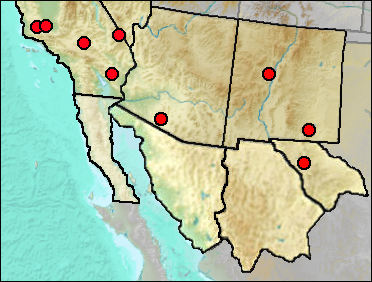
There is considerable mystery as to where V. macrotis was during full glacial times. Though Conkling (1932:16) reported "desert Kit Fox (Vulpes)", there is no reason to assume that this actually applied at the species level to V. macrotis. Colbert (1950) did report this species from Ventana Cave; if the species identification is correct, this may be an indication of where it spent the late Wisconsin. All other sites in the eastern portion of the region reporting V. macrotis are those with collections at UTEP.
Jasso (2001) utilized a suite of measurements in an attempt to discriminate between the three species of Vulpes found in New Mexico and to try to apply her findings to fossil Vulpes. She found that measurements of V. velox were larger than those of V. macrotis except for three measurements having to do with the auditory bullae and total lengths of the tibia and fibula. However, though size differences generally were statistically significant, there is appreciable overlap.
Jasso (2001) applied data obtained from modern specimens to 551 fossil specimens from New Mexico and concluded that about 500 were identified with reasonable certainty. She identified 17 as V. macrotis, 472 as V. velox, and 23 as V. vulpes. Four sites contained elements identified as V. macrotis: Harris' Pocket (2 macrotis, 12 velox); Animal Fair (3 macrotis, 28 velox); Isleta Cave No. 1 (2 macrotis, 39 velox); Isleta Cave No. 2 (10 macrotis, 314 velox).
Isleta Cave No. 1 and No. 2 are known to include Holocene material (and at least the specimens from Isleta Cave No. 1 do indeed appear to be Holocene), and they currently are in the geographic range of V. macrotis; arguably, the 12 specimens out of 365 total from the Isleta Caves are Holocene. On the other hand, Harris' Pocket and Animal Fair are pure Pleistocene in content, so the question as to where V. macrotis was during the late Wisconsin depends on those five specimens. One specimen is a fragmentary fibula basically unidentifiable. Reexamination indicates that three of the other four are well within the range of variation of V. velox and are so assigned. The remaining specimen, a femur from the NW Talus Slope, on the basis of size appears to be good V. macrotis and is associated with other remains (e.g., a cranium with bullae) that clearly are V. velox. In Fig. 1, two femurs from the site are compared (note the stockiness of the middle one compared to the modern one on the left). A partial radius from the NW Talus Slope not considered by Jasso tentatively is identified as V. macrotis.
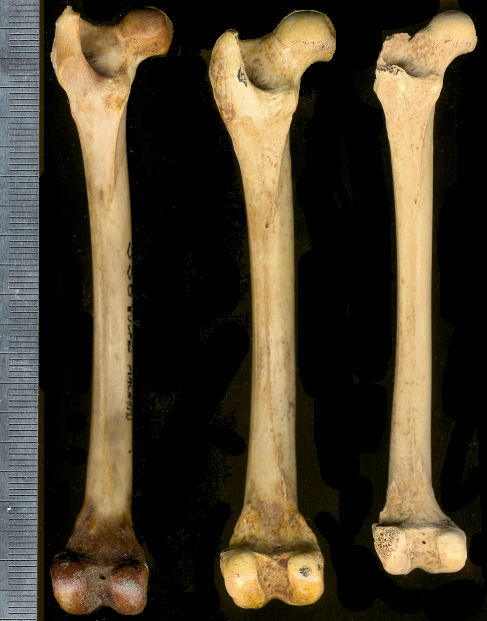
Fig. 1. Comparison of a modern femur of a Vulpes from within the hybrid zone near Carlsbad (left; UTEP Mammal Collection 338) with a femur of V. velox from the NW Talus Slope of Dry Cave (middle; right femur reversed for comparison; UTEP 22-239) and a femur of V. macrotis from the same site (right; UTEP 22-240).
It appears that the femur is the only reasonably sure identified New Mexican specimen of V macrotis that is of Pleistocene age. The NW Talus Slope is older than the Animal Fair date of about 15,000 BP and may be late mid Wisconsin. The presence of both species may indicate a tension zone at that time encompassing Dry Cave similar to that of the area today. The identification of V. velox from the probable mid Wisconsin site Pit N&W Animal Fair complicates the picture. Unfortunately, there are no other identifiable specimens from the mid Wisconsin which might give further information.
Outside of our area, there are several Pleistocene sites in California that have reported this taxon, and the Lubbock Lake Site a bit to the east of our region reported V. macrotis from Clovis-age sediments (Johnson 1987). The latter is of interest in that Lubbock Lake is well within the range of V. velox today and Johnson specifically implied that the skull and mandibles are not of V. velox. She indicated a date of about 11,100 BP, and this, then, may mark the return of V. macrotis to the Southwest.
Sites.
Rancholabrean: Cool Water Coal Gasification Solid Waste Site (Jefferson 1991b); Desert Sunlight Project (Jefferson 2014).
Mid Wisconsin: McKittrick (Schultz 1937).
Mid/Late Wisconsin: NW Talus Slope (Harris 1993c).
Mid/Late Wisconsin/Holocene: Sierra Diablo Cave (UTEP cf.)
Late Wisconsin: Maricopa (Jefferson 1991b); Ventana Cave (Colbert 1950).
Late Wisconsin/Holocene: Isleta Cave No. 2 (Harris 1993c); Kokoweef Cave (Reynolds, Reynolds, et al. 1991); Luz Solar Trough (Jefferson 1991b: cf.).
Holocene: Isleta Cave No. 1 (UTEP).
Literature.
Colbert 1950; Conkling 1932; Harris 1993c; Jasso 2001; Jefferson 1991b, 2014; Johnson 1987; Reynolds, Reynolds, et al. 1991; Schultz 1937.
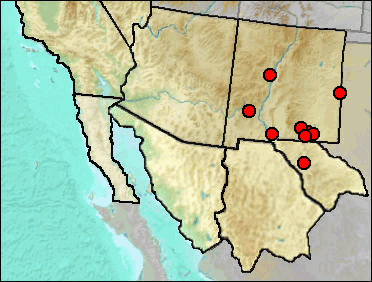
Vulpes velox is a grassland fox of the Great Plains. Somewhat larger size, but smaller auditory bullae, differentiate it from the Kit Fox. This is the common fox of the late Pleistocene in the sites on the east side of the Guadalupe Mountains and in the north-central Isleta Caves sites. It is uncommon in the southern New Mexican sites west of the Guadalupes. The Pendejo Cave specimen is a burned, poorly preserved dentary with alveoli indicating larger size than V. macrotis but apparently smaller than V. vulpes.
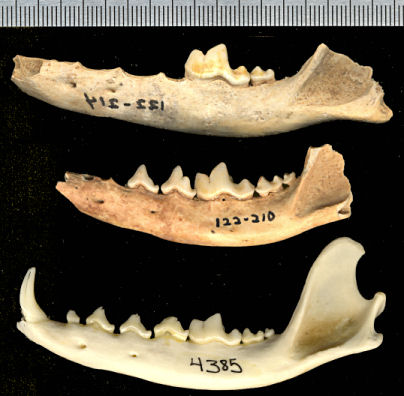 Identification
of material from the Pit N&W Animal Fair site was recorded (Harris 1993c) as
Vulpes sp. It since has received further study (Jasso 2001, this project) and is
assigned to V. velox. The Howell's Ridge Cave record (Harris 1993c) of
Vulpes sp. apparently lacks a voucher and is rescinded.
Identification
of material from the Pit N&W Animal Fair site was recorded (Harris 1993c) as
Vulpes sp. It since has received further study (Jasso 2001, this project) and is
assigned to V. velox. The Howell's Ridge Cave record (Harris 1993c) of
Vulpes sp. apparently lacks a voucher and is rescinded.
Fig. 1. Two fossil dentaries (top image reversed for comparison) from the Pit N&W Animal Fair assigned to Vulpes velox compared to a modern dentary of Vulpes macrotis. Despite considerable size differences between the two fossils, the m1 of both are notably larger than in V. macrotis. Scale in mm.
Sites.
Rancholabrean: Palomas Creek Cave (Harris 1993c: cf.).
Mid Wisconsin: Pendejo Cave (UTEP: cf.).
Mid/Late Wisconsin: Dark Canyon Cave (Harris 1993c: cf.); Hampton Court (Harris 1993c); NW Talus Slope (Harris 1993c).
Mid/Late Wisconsin/Holocene: Sierra Diablo Cave (UTEP).
Late Wisconsin: Algerita Blossom Cave (Harris 1993c); Animal Fair 18-20 ka (Harris 1989); Big Manhole Cave (Harris 1993c); Bison Chamber (Harris 1989); Blackwater Draw Fauna (Lundelius 1972); Camel Room (Harris 1993c: cf.); Charlies Parlor (Harris 1989); Harris' Pocket (Harris 1989); Human Corridor (Harris 1993c); Stalag 17 (Harris 1993c); TT II (Harris 1993c).
Late Wisconsin/Holocene: Balcony Room (Harris 1993c); Burnet Cave (Schultz and Howard 1935); Conkling Cavern (Harris 1993c); Isleta Cave No. 1 (Harris 1993c); Isleta Cave No. 2 (Harris 1993c).
Literature.
Harris 1989, 1993c; Lundelius 1972; Schultz and Howard 1935.
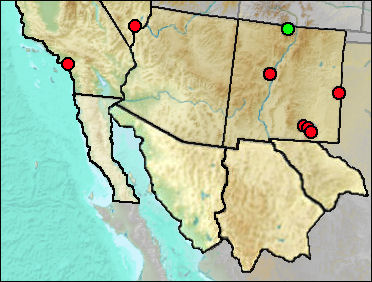
Synonyms. Vulpes macroura.
Frey (2004) noted that there are two subspecies in New Mexico and that one is native while many or all of the Red Foxes from the eastern plains of New Mexico ultimately may be from introductions in Texas or eastern New Mexico. The native subspecies inhabits the northern mountains and San Juan Basin, coming south mostly in the mountains. The eastern group is reported from most of the eastern counties, especially those of the Llano Estacado and the Pecos Valley from Eddy County northward.
Jasso (2001) in her study of three species of Vulpes found that, as expected, the Red Fox is larger in virtually all cranial and long-bone measurements.
Sites.
Medial Irvingtonian: SAM Cave (Rogers et al. 2000).
Mid/Late Wisconsin: Dark Canyon Cave (Tebedge 1988).
Late Wisconsin: Blackwater Loc. No. 1 (Slaughter 1975: cf.); Camel Room (Harris 1993c: cf. gen. et sp.); Gypsum Cave (Jefferson et al. 2015); Park Place, Irvine (Jefferson 2014).
Late Wisconsin/Holocene: Burnet Cave (Schultz and Howard 1935); Isleta Cave No. 1 (Harris 1993c); Isleta Cave No. 2 (Harris 1993c).
Literature.
Frey 2004; Harris 1993c; Jasso 2001; Jefferson 2014; Jefferson et al. 2015; Rogers et al. 2000; Schultz and Howard 1935; Slaughter 1975; Tebedge 1988.
Last Update: 4 Feb 2016